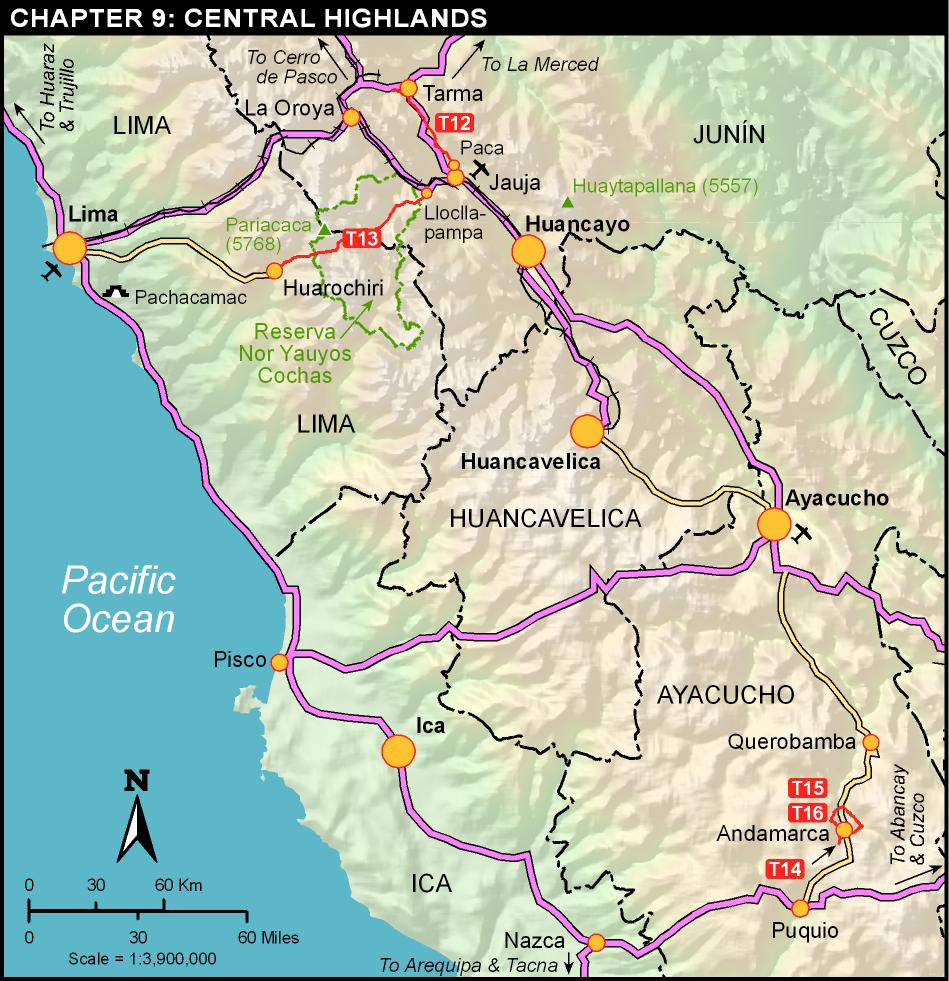 |
T R E K K I N G P E R U
|

|
|
CHAPTER 9 
Located between the Cordillera Blanca
and Cuzco, the often-overlooked Central
Highlands await trekkers who appreciate
the unbeaten path. In addition to gorgeous
scenery, this region features important
pre-Inca and Inca archaeological sites
and roads, colonial cities, renowned
folklore, and splendid crafts. At the
heart of this extensive area spanning various
departments is the congenial city of
Ayacucho, originally called Huamanga. It
has fine colonial architecture, its own gastronomy,
craft workshops, and outstanding
Holy Week processions.

The Sendero Luminoso movement was
conceived at the University of Ayacucho,
and the Central Highlands were among
the areas most severely affected during
the insurgent campaign (see Two Decades
of Terror, Chapter 2). For a better understanding
of this violent period, visit the
Museo de la Memoria ANFASEP (see
Appendix A) in Ayacucho. Since 2000,
peace has returned and, despite the scars
left by this terrible period, people in the
Central Highlands are very friendly and
welcoming
...
Trek 12 HUASQUI TO LAGUNA PACA FOLLOWING THE CAPAC ÑAN 
THIS IS SOMETHING OF a bittersweet trek, highlighting both the past glories of
the Capac Ñan (The World’s Greatest Road, Chapter 1) and—in places—its current
state of neglect and decay. Along the way are beautiful scenery, villages, estancias, and
archaeological sites. The hiking is not too strenuous, but navigation can be challenging,
especially as more and more modern roads encroach on the ancient one
...
Trek 13 LLOCLLAPAMPA TO HUAROCHIRI STAIRWAY TO HEAVEN 
AMONG THE ANCIENT ROADS connecting the highlands and the coast, the one
from Jauja to Pachacamac stands out for its historical significance, monumental 1800-
step stairway, and excellent state of preservation. Starting well before Inca times, pilgrims
traveled it between the great sanctuaries of Pariacaca, southwest of Jauja, and
Pachacamac, south of today’s Lima. Worship of Pariacaca, one of the most venerated
apus in Peru, is described in the 16th-century Manuscrito de Huarochirí (see Dioses y hombres
de Huarochirí and Ritos y tradiciones de Huarochirí in Appendix A). So great was the
apu’s prestige that all wars are said to have been suspended during its annual festival.
The sanctuary of Pariacaca was destroyed by the Spaniards, and even its location has
been lost, but reverence of the apu endures. Herdsmen who travel this route offer tributes
to it at apachetas along the way, and tributes are also paid during the Fiesta de
Santiago (see sidebar in this chapter). At the end of the trek in Huarochiri, a massive
colonial church sits on a stone platform of Inca or pre-Inca origin
...
Trek 14 PUZAPAQCHA WATERFALL A SOURCE OF LIFE 
THE MOST REMARKABLE FEATURE
of the Sondondo valley is the
extensive ancient terracing of its slopes.
Over the centuries, one culture after
another modified its surroundings to
create this productive and strikingly
beautiful landscape. Some 5600 hectares
of agricultural terraces were built
mainly by the Wari nation; some were
improved by the Incas. To bring life to
the terraces, reservoirs and elaborate
irrigation and drainage systems were
devised. At higher altitudes, springs
were diverted to expand bofedales where
camelids graze. Perhaps most astonishing
is that many of these terraces,
canals, and bofedales are still in use
...
Trek 15 LUICHUMARKA MAQUETTE PERU’S FIRST MAP? 
MOST TREKKERS LOVE MAPS, and finding an ancient stone map along the trail
is pretty amazing. Scattered about the Sondondo valley are a number of maquettes or
scale models, believed to date to Wari times. It is likely that these engraved boulders
were models, used in planning the transformation of an area. Perhaps they were replicas,
not-so-instant photos of an existing landscape. Or maybe they were just decorations.
Carved into the rock are miniature terraces, ponds, and irrigation canals.
According to the chronicles, the Incas used clay or sculpted-stone models in planning
structures and for military strategy. The Mochica, on the coast, also had maquettes. The
model-building tradition has not been completely lost. Today, one maquetero, Sr Julián
Cuaresma, remains in the Mayobamba area (see Trek 16), continuing the tradition he
learned from his father and grandfather
...
Trek 16 SONDONDO CIRCUIT TIMELESS VALLEYS 
THE SELDOM-VISITED SONDONDO REGION offers an incredible variety of
attractions. Start with wonderful scenery, endless ancient agricultural terracing (much
of it still in use, see Trek 14), and unique scale-model landscapes carved in stone (Trek
15). Here too are several Wari and Chanca archaeological sites, ancient roads, lakes,
waterfalls, and hot springs, not to mention the highest concentration of condors in
the country. Stands of Puya raimondii (see Queen of the Andes, Chapter 2), meteorite
craters, miniature volcanoes, and an exceptionally rich cultural heritage round out the
wonderful cornucopia. Although Sondondo is off the tourist trail, it is easily accessible
along the overland route from Lima to Cuzco via Nazca.
...
|
| English • Español | www.trekkingperu.org | © Robert & Daisy Kunstaetter |